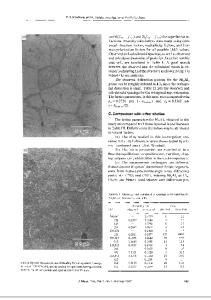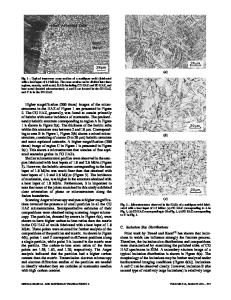Investigation of the heat-affected zone fracture in Ni 3 Al welds
- PDF / 2,755,088 Bytes
- 7 Pages / 576 x 792 pts Page_size
- 20 Downloads / 328 Views
Ternary Ni77Al23_>,X}, (X = Zr or Hf, y = 0.5 or 1) + 500 ppm boron compounds with various grain sizes were welded by a CO2 laser. Fractographic examinations of the heat-affected zone (HAZ) in the welds with or without postweld heat treatment (PWHT) were performed on the impact-fractured specimens. In laser welds, the fracture appearance of the HAZ was mixed transgranular/intergranular modes for fine-grained alloys and intergranular mode for coarse-grained materials. However, an entirely transgranular mode was observed in the base metal regardless of the grain size of the compounds. Boron desegregation at high temperatures during the thermal cycle of welding could be used to explain the fractographic change from originally ductile mode into less-ductile or even brittle fracture in the HAZ. Short-term PWHTs along with slow cooling provided sufficient time for boron segregation back to the grain boundary, resulting in a completely transgranular fracture mode in the fine-grained HAZ. Nevertheless, such a phenomenon was not observed in the HAZ of coarse-grained welds. Cracks in the HAZ of coarse-grained welds after long-term PWHT, if not so severe, could be healed by a sintering process.
I. INTRODUCTION Investigations of Ni3Al intermetallic compounds as high temperature structural materials have been of great interest in recent years. Ni3Al sustains long-range order structure up to its melting temperature, exhibits unusual temperature dependence on yield strength,1'2 and excellent oxidation resistance.3 Previous studies have indicated that the inherent grain boundary brittleness of Ni3Al impedes the applicability of Ni3Al in polycrystalline form,4 whereas the addition of boron in trace amounts significantly improves the ductility of this compound. 45 For structural applications, weldability is an important consideration in the developing process of a material. Recent works indicated that HAZ cracking is the main problem associated with the welding of N^Al. 6 " 10 The reduction of boron addition (optimum amount 200 ppm) in Ni3Al and the decrease of welding speed have been reported to effectively overcome this problem in electron beam welds.6 The addition of Hf to a Ni3Al + 200 ppm boron alloy has been found to improve resistance to HAZ cracking.8'9 Our previous study also indicated that grain refinement is beneficial to the weldability of Ni3Al with various boron contents.10 To maintain good weldability, the control of grain size below a certain critical value is very important. Although the emphasis in these studies has been on the elimination of the HAZ cracking, the main cause of HAZ cracks is still not clear. Choudhury et al.n reported that slow cooling promotes grain boundary segregation of boron in Ni3Al, 1076 http://journals.cambridge.org
J. Mater. Res., Vol. 7, No. 5, May 1992 Downloaded: 14 Mar 2015
while rapid quenching retains the low boron level at high temperatures. It was also found that the effect of boron on the improvement of Ni3Al ductility disappears above a critical temperature range.12 It is impl
Data Loading...











